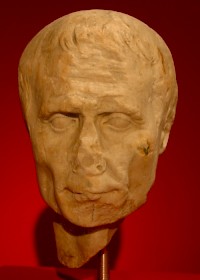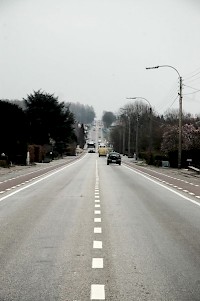Germania Inferior (2)
Q152136Germania inferior: small province of the Roman empire, situated along the Lower Rhine. Its capital was Cologne.
Tribes and languages

When Julius Caesar gave a description of the country north of the Alps, he made a simple distinction: the river Rhine was the frontier between the Gauls in the west and the Germans in the north. In fact, this is nonsense.
The Gauls belonged to what archaeologists call the La Tène-culture, and they spoke a language that linguists call Celtic. The situation on the opposite bank of the Rhine is less clear-cut. The Middle-Rhine was certainly not a cultural frontier zone: both the La Tène-culture and the Celtic language are attested in Baden-Württemberg, Bavaria, and further down the Danube. Caesar was also wrong in his description of the delta of the Rhine. In the area between the rivers Somme and Weser, a language was spoken that was neither Germanic nor Celtic. (Linguists call it Belgian; the existence of this archaic language can be deduced from place names and the names of ancient deities like Nehalennia.) However, the region was becoming germanized, something that Caesar more or less admits when he makes a distinction between the "normal" Gauls and the Belgians of the north.
In the preceding article, we have seen that three tribes from the east bank of the Rhine were resettled on the west bank. In 39-38, Marcus Vipsanius Agrippa led the Ubians to the region of modern Cologne and brought a large group of Chatti to the delta of the Rhine, where they became known as Batavians. Thirty years later, Tiberius deported the Sugambri and settled them near Xanten; their new name was Cugerni. We do not know what language these tribes spoke, and archaeologically speaking, they belong to a culture that stands somewhere between the Germanic culture and the La Tène-culture. If we call these tribes "Germanic", it is only because Caesar had used this word to describe all inhabitants of the east bank of the Rhine.
Whatever the precise situation during the decades before the beginning of the common era, the result of the Roman conquest is clear. The tribes on the west bank became completely romanized and started to speak Latin. There is not a single inscription from the Ubians, Cugerni, or Batavians that is not written in the language of the Romans. On the other bank of the river, the countries that were evacuated by the Sugambri/Cugerni, Ubians and Chatti/Batavians became increasingly germanized.
So we are left with a strange conclusion. When Caesar arrived and give a first description of the Low Countries, the Rhine was neither a cultural nor a linguistic border. But half a century later, the situation started to resemble the description.
Romanization: first stage
The ancient Greeks and Romans were convinced that civilized life was possible only in cities. The famous philosopher Aristotle of Stagira had once defined mankind as "the species that dwells in towns", and many people shared his view. Therefore, the emperor Augustus initiated a policy of urbanization: the barbarians had to become civilized people, who could be governed in a normal way. The easiest way was to build new cities and give them to veterans, a policy with the additional advantage that the inhabitants were Italians, and would spread the civilized way of life to the north. Tongeren originated in this way.
Other cities were founded by relocating the inhabitants of other towns. An example is Huy in the Meuse valley, which had once been a citadel of the Aduatuci and had been captured by Julius Caesar after a brief siege (more). The settlement on the hilltop was never used again; instead people started to live at Amay in the river valley, where they had easy access to the trade routes (and could not defend themselves against the Roman forces in case of rebellion).
The third and most important factor contributing to the urbanization of Gallia Belgica, however, was in fact a bureaucratic misunderstanding. Every Belgian tribe had several settlements of equal importance: for example, the Nervians had at least four important hillforts (at Asse, Elewijt, Binchem and Bliquy). The Romans did not really understand that a political unit could have more than one center; to them, a normal political entity consisted of one city and its environments. Therefore, they chose one of the tribal settlements as administrative center, and thought that all other settlements were of less importance. If there was no suitable tribal capital, they founded one, e.g., Bavay, henceforth the Oppidum Nerviorum, city of the Nervians, par excellence.
Although the new administrative center was not a real city yet, this changed rapidly. Here, the governor of the province administered justice; here, the Roman gods received their temples; here, merchants knew they could meet Roman customers - the right to hold a market was one of the privileges of these capitals. Artisans also understood where they could find customers, and native noblemen who wanted to be seen by the Romans (because this would advance their career), built conspicuous houses in these boom towns. Surveyors saw to it that the town was well-organized, with the gridiron lay-out that the Romans liked so much.
The towns were governed by members of the old tribal elite, who were acceptable to the populace. After all, they had always been the leaders of the tribe. They were also necessary intermediaries when taxes (in kind) had to be paid, because they had large store-rooms and could forward whatever product the Roman government requested. The governor only had to administer criminal justice, and controlled the elite.
This system was advantageous to the elite as well. Of course, they had lost the right to wage war, but they could serve in the Roman auxiliaries and could become magistrates. Soon, they received the Roman citizenship, and started to behave like other Romans. After all, by wearing a toga, speaking Latin, sending their children to a Roman school, they showed to the rest of the tribe whose power was standing behind their own. Other members of the tribe followed soon. This was the first stage of the romanization.
Romanization: second stage
The next stage can be dated after the beginning of Drusus' wars on the east bank of the Rhine. As we have seen above, after 16, the legions were transferred to this river, where two military zones were created: Germania Inferior and Germania Superior. Until then, they had been stationed on several places in Gaul. The replacement created a major problem, because the military zones were too small to produce sufficient food for 30,000 legionaries and as much auxiliaries. The solution was the monetarization of the economy; the (unintended) consequence was an additional boost to romanization, as we will see in an instant.
Until then, the tribes had had to pay taxes in kind; from now on, the owners of large estates (fundi) in Gallia Belgica had to pay coins. Tax districts were created with names like Mogontiacum, Cortoriacum, Feliciacum, Tiberiacum, Arenacum, and Mannaricium (i.e., Mainz, Kortrijk, Velzeke, Thorr, Rindern, and Maurik). The only way in which the owners of the fundi could earn money, was to sell something - and this meant that the Low Countries became part of a market economy. To be more precise, if taxes were to be paid, the landowners had to produce something that was in great demand. In these years, the first terra nigra ceramics were produced along the Meuse. At the same time, the production of salt, iron, cattle, and ham increased. Celtic Fields agriculture was replaced by Roman types of agricultural exploitation.

But the most important product was wheat. It was produced on the fertile loess of the Walloon provinces of what is now called Belgium. The Romans built a straight road from Bavay (the capital of the Nervians) to Tongeren (the capital of the Tungri) and Cologne (the capital of the Ubians), which became the economic artery of the region. The food supply of the legions depended solely on this street.
Summing it all up: the political reorganization after the conquest resulted in urbanization, the fiscal reorganization led to economic development. This second stage of the romanization, however, only took place in the 'civic' area, i.e., the hinterland of the military zones along the Rhine. In other words: in Gallia Belgica, which became a 'tax exporting region'. Germania Inferior and Germania Superior had a different development: here, there was no such incentive for economic development. After all, the military zone was a 'tax importing region': here the Roman soldiers spent their wages. We must now take a look at the army.